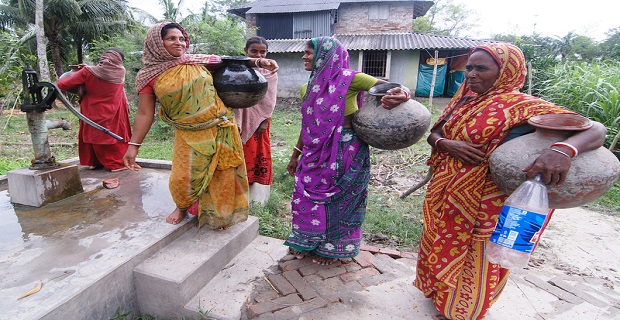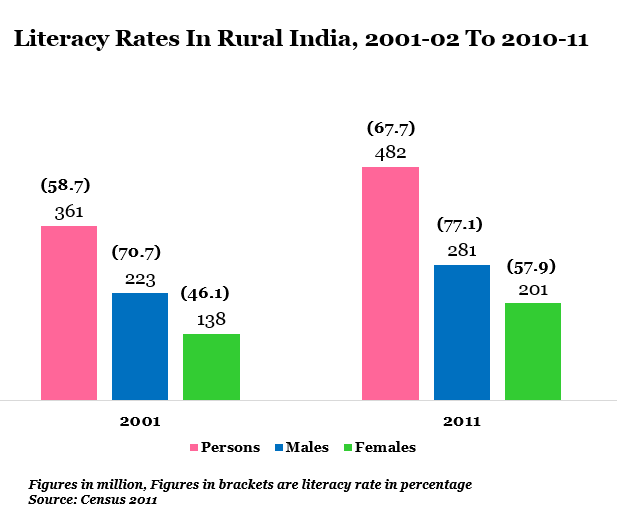A Statistical Profile Of India's 'Dehati’ Woman

| Highlights *Overall sex ratio (number of women per 1,000 men) improved only marginally in rural areas from 946 to 947 between 2001- 2011 * Female literacy rate increased in rural areas from 46.1% to 57.9% during 2001-2011 *More rural women participate in labour force compared with urban women |
Pakistan Prime Minister Nawaz Sharif triggered a huge row last week when he apparently called Indian Prime Minister Manmohan Singh a ‘Dehati’ (rural) woman. A comment he later denied.
True or not, we thought this would be a good occasion to embark on a small statistical journey to show (or remind) what it really means to be a woman in rural India.
We decided to look at various aspects like sex ratio, literacy rate, employment and financial independence based on how many of them are actually joining self-help groups under the National Rural Livelihood Mission (NRLM).
The broad numbers. Of the 587 million women in India, more than half of them - 405 million - are in rural areas, according to Census 2011. The overall sex ratio (number of women per 1,000 men) improved only marginally in rural areas from 946 to 947 between 2001- 2011. The real improvement was seen in urban areas where the sex ratio improved from 900 to 926 during the same time.
Figure 1(a)
Figure 1(b)
The sex ratio of children in 0-6 years shows that the rural areas have seen a greater fall from 934 to 919 - a drop of 15 points. This also goes to show the higher preference for male child rather than females…
Let us now look at literacy in rural areas.
Figure 2(a)
The overall literacy rate in rural India has increased from 58.7% in 2001 to 67.7% in 2011. Most of this growth has been propelled by the increase in the female literacy rate, which increased from 46.1% to 57.9% during 2001-2011. The number of females who have become literate has increased 45% while the number of literate males increased by only 26% in the same time period.
Figure 2(b)

The overall female literacy rate has gone up by 31% from 224 million in 2001 to 328 million in 2011. While the literacy rate in rural India has increased to 58% from 46%, the literacy rate for urban females shows a growth from 73% to 79% in the same time period.
Where are more women participating in the workforce – rural or urban India?
Table 1
Labour force participation rate (LFPR), which is the ratio of labour force-to-population, is only 16 women (per 1000 females) in urban areas while it is 25 (per 1000 females) for rural females. The worker population ratio (WPR) again shows that rural females have a higher participation rate than their urban counterpart. And we can also see that unemployment is higher among urban females. One of the reasons highlighted for higher employment in rural areas is the employment generation programme (MGNREGA).
When it comes to financial inclusion, there is a clear bias towards urban areas. According to the recent census, out of 199 million households in India, only 68 million households have access to banking services. As far as rural areas are concerned, out of 138 million rural households in India, only 42 million (30%) have access to basic banking services. In urban areas, out of 61 million households, nearly 50% households have access to banking services.
One of the ways in which the government has tried to ensure financial inclusion in rural areas is through self-help groups. The National Rural Livelihood Mission (NRLM) was launched to touch rural India and build livelihoods. The table below shows the growth of self-help groups in rural areas headed by women.
Figure 3
So, we can see that the number of self-help groups with saving accounts has increased from 5.3 million to 5.9 million from 2009 to 2013. According to a report by National Bank For Agriculture & Rural Development, the nearly 6 million SHGs reach 95 million people as on 31 March, 2013.
The highest point was reached in 2011-12 with 6.2 million SHGs, which then came down to 5.9 million in 2012-13. One of the reasons given for the decline is the new Reserve Bank of India guidelines on data cleansing wherein banks were asked to report only active accounts.
SHGs having savings account is only considered the first step to financial inclusion; the real indicator would be the loans disbursed to SHGs. If we look at the table, we can see that the number of SHGs receiving loans has come down from 1.2 million in 2009-10 to 1 million in 2012-13. The lowest point was seen in 2011-12 where the number of SHGs that availed loans came down to 0.9 million.
This tends to shows that commercial banks are cautious while lending to SHGs. The improvement in 2012-13 is attributed to the fact that banks have begun lending to SHGs with good credit history.
So, a rural woman in India faces battles that begin from her birth - with the declining child sex ratio - to accessing loans through SHGs. There are, however, a few good developments like increasing literacy rates and more and more women learning to read and write.
The employment numbers also show a higher participation rate for rural women. Whatever and whenever opportunities are provided to rural women, they seem to grab them; for example, the formation of SHGs under Swarnajayanti Grameen Swarozgar Yojana. So, what's wrong in being Dehati? Well, we are not sure. We will leave it to you to decide.







